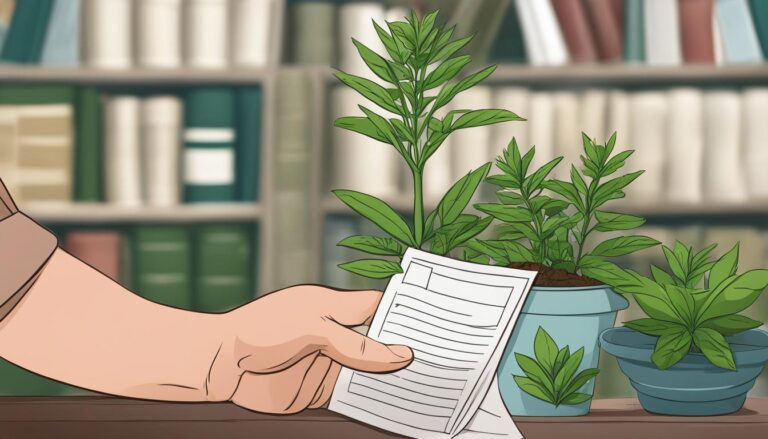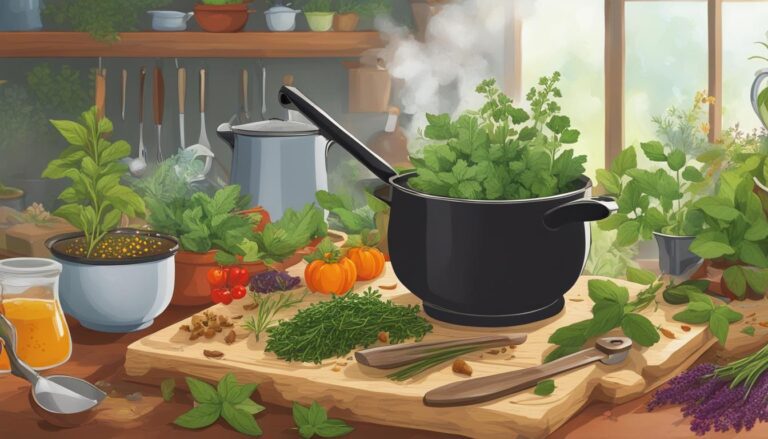
There are various effective powdery mildew cures and treatments, including natural remedies and sprays that can be made at home. These remedies include milk spray, baking soda spray, and the use of sulfur or copper-based fungicides.
Powdery mildew is a common fungal disease that affects many different types of plants. It appears as white, powdery spots on leaves, stems, and fruit.
The disease thrives in warm, dry climates with high humidity. It can cause leaves to turn yellow, curl, and eventually drop. By taking preventative measures and treating powdery mildew early, you can keep your plants healthy and free from this fungal disease.
Key Takeaways:
- Powdery mildew is a fungal disease that affects various plants, causing white, powdery spots on leaves, stems, and fruit.
- It thrives in warm, dry climates with high humidity.
- Effective cures and treatments for powdery mildew include natural remedies such as milk spray and baking soda spray, as well as sulfur or copper-based fungicides.
- Taking preventative measures and treating powdery mildew early can help keep your plants healthy and free from this fungal disease.
- Monitor your plants regularly for signs of powdery mildew and take action at the first sign of infection.
Understanding Powdery Mildew and Its Symptoms
Powdery mildew is a common fungal disease that affects a variety of plants, including squash, tomatoes, roses, and zinnias. It appears as white, powdery spots on leaves, stems, and fruit. The disease thrives in conditions of low soil moisture and high humidity.
Symptoms of powdery mildew include raised blister-like areas on young leaves, white or gray powdery growth on infected leaves, and brown, dropping leaves on severely infected plants. It is important to understand the symptoms of powdery mildew so that you can take appropriate preventative measures and treat the disease effectively.
Symptoms of Powdery Mildew:
- Raised blister-like areas on young leaves
- White or gray powdery growth on infected leaves
- Brown, dropping leaves on severely infected plants
Powdery mildew can quickly spread from plant to plant, so it is crucial to identify and address the symptoms as soon as possible. By doing so, you can prevent the disease from causing further damage and ensure the health and vitality of your plants.
Understanding the symptoms of powdery mildew can help you differentiate it from other diseases or issues that may affect your plants, allowing for accurate treatment and control.
Preventing Powdery Mildew:
- Choose powdery mildew resistant plant varieties
- Ensure proper spacing between plants to allow for good air circulation
- Water plants at the base, avoiding excessive moisture on leaves
- Remove and destroy infected plant material
- Apply fungicides or natural remedies as preventative measures
By understanding the symptoms of powdery mildew and implementing preventative measures, you can effectively control the disease and keep your plants healthy. Regular monitoring and prompt action are key to preventing the spread of powdery mildew and ensuring a thriving garden.
| Plant | Powdery Mildew Resistant |
|---|---|
| Tomatoes | No |
| Squash | Yes |
| Roses | No |
| Zinnias | Yes |
Plants Most Affected by Powdery Mildew
Powdery mildew is a common fungal disease that can affect a wide variety of plants. However, there are certain plants that are more susceptible to powdery mildew than others. It is important to be aware of these plants so that you can take extra precautions to prevent and manage powdery mildew in your garden.
Nightshades:
Nightshade plants such as tomatoes, eggplants, and peppers are highly susceptible to powdery mildew. These plants are often grown for their fruits, which can be severely affected by the disease. Regular monitoring and preventive measures are essential for keeping powdery mildew at bay.
Cucurbits:
Cucurbits, including cucumbers, melons, and squash, are also prone to powdery mildew. These plants have large, broad leaves that provide an ideal environment for the fungus to thrive. It is important to practice good air circulation and implement preventive strategies to protect your cucurbits from this disease.
Legumes:
Beans and peas, which belong to the legume family, can also be affected by powdery mildew. Powdery mildew can cause stunted growth and reduced yields in legume crops. It is crucial to choose resistant varieties and practice proper plant care to minimize the impact of the disease.
Other ornamental plants like lilacs, hibiscus, and zinnias can also be susceptible to powdery mildew. By being aware of which plants are most affected by powdery mildew, you can take proactive steps to prevent and manage the disease, ensuring that your garden remains healthy and vibrant.

How Powdery Mildew Spreads
Powdery mildew is a fungal disease that can easily spread from plant to plant, causing damage to your garden. Understanding how powdery mildew spreads is crucial in preventing its spread and controlling its impact. Powdery mildew spores are primarily spread through wind, water, and insects.
These spores can enter your garden through the wind or be transmitted by water splashing from infected plants. They can also be carried by insects that come into contact with infected plants. Once powdery mildew spores find a suitable host plant, they germinate and grow, eventually forming visible signs of infection.
It’s important to note that powdery mildew thrives in dry and warm climates, but requires high relative humidity to spread. Shady areas with limited airflow are particularly conducive to its growth.
Powdery mildew can overwinter in leaf buds and plant debris, making it important to remove any infected leaves or debris from your garden to prevent its spread.
How to Prevent the Spread of Powdery Mildew
To prevent the spread of powdery mildew in your garden, there are several steps you can take. Firstly, maintaining good air circulation is crucial. Trim or prune any overcrowded plants to allow for better airflow.
This will help reduce the humidity levels and discourage the growth and spread of powdery mildew. It’s important to keep your plants dry. Avoid overhead watering, as wet leaves provide an ideal environment for powdery mildew to thrive. Instead, water at the base of the plants to keep the foliage as dry as possible.
Regularly inspect your plants for any signs of powdery mildew and take immediate action if you spot any symptoms. Remove and destroy any infected leaves or plant debris to prevent the disease from spreading further. Disinfecting your gardening tools after each use can also help prevent the transmission of powdery mildew spores.
Powdery mildew can be a frustrating problem in the garden, but with the right preventative measures, you can keep it under control. By understanding how powdery mildew spreads and taking proactive steps to prevent its spread, you can enjoy a healthy and thriving garden.
Tips for Preventing Powdery Mildew Spread:
- Maintain good air circulation by trimming or pruning crowded plants.
- Avoid overhead watering and ensure plants are watered at the base.
- Regularly inspect plants for signs of powdery mildew and remove infected leaves.
- Disinfect gardening tools after each use to prevent the spread of the disease.
By following these tips, you can significantly reduce the risk of powdery mildew spreading in your garden and keep your plants healthy and vibrant.
Preventing Powdery Mildew Infection
When it comes to powdery mildew prevention, there are several measures you can take to reduce the risk of infection in your garden. By implementing these strategies, you can help keep your plants healthy and powdery mildew-free.
Plant Resistant Cultivars
Choosing resistant varieties of plants is one effective way to prevent powdery mildew. Look for cultivars that are known to have natural resistance to the disease. These plants have been bred to be less susceptible to powdery mildew, reducing the likelihood of infection.
Improve Air Circulation
Powdery mildew thrives in humid, stagnant air. By improving air circulation in your garden, you can create an environment that is less favorable for the disease. Pruning or staking plants to remove dense foliage and allow air to flow freely can help prevent powdery mildew.
Remove Infected Foliage
If you notice any signs of powdery mildew on your plants, it’s important to take immediate action. Remove any infected foliage as soon as possible to prevent the disease from spreading. Dispose of the infected leaves in a sealed bag or burn them to prevent the spores from re-infecting your plants.
Proper Watering and Fertilizing
Watering your plants in the morning allows them to dry during the day, reducing the risk of powdery mildew. Avoid overhead watering, as it can create a moist environment that promotes fungal growth. Additionally, be careful not to over-fertilize your plants with nitrogen-rich fertilizers, as this can make them more susceptible to powdery mildew.
| Preventive Measures | Description |
|---|---|
| Plant Resistant Cultivars | Choose plant varieties that are naturally resistant to powdery mildew. |
| Improve Air Circulation | Prune or stake plants to remove dense foliage and improve air circulation. |
| Remove Infected Foliage | Remove any infected leaves as soon as possible to prevent the spread of powdery mildew. |
| Proper Watering and Fertilizing | Water plants in the morning and avoid over-fertilizing with nitrogen-rich fertilizers. |

By following these preventive measures, you can significantly reduce the risk of powdery mildew infection in your garden. It’s important to be proactive and take action at the first sign of the disease to prevent its spread. With proper care and attention, you can keep your plants healthy and powdery mildew-free.
Treating Powdery Mildew Effectively
Powdery mildew is a common fungal disease that can quickly spread and damage your plants. Luckily, there are various effective treatments available to help you combat this pesky fungus. Whether you prefer organic solutions or commercial sprays, there is a method that will suit your needs.
One popular organic remedy is milk spray. This simple mixture of milk and water can be applied directly to the affected plants. The proteins in the milk act as a natural fungicide, inhibiting the growth of powdery mildew.
Another effective homemade remedy is baking soda spray. By combining baking soda, liquid soap, and water, you can create a powerful spray that will rid your plants of powdery mildew.
If you prefer commercial products, sulfur or copper-based fungicides are proven powdery mildew fighters. These sprays can be easily found at your local garden center and are simple to use. There are broad-spectrum bio-fungicides available, such as SERENADE Garden, which utilize beneficial bacteria to combat the fungus.
When using any treatment, it is important to follow the instructions carefully and apply the sprays according to the recommended schedule. Regular and thorough application is key to effectively treating and preventing powdery mildew on your plants.
| Treatment | Description |
|---|---|
| Milk Spray | A mixture of milk and water that acts as a natural fungicide |
| Baking Soda Spray | A combination of baking soda, liquid soap, and water that helps eliminate powdery mildew |
| Sulfur or Copper-based Fungicides | Commercial sprays that effectively kill powdery mildew |
| Broad-spectrum Bio-fungicides | Products like SERENADE Garden that use beneficial bacteria to combat powdery mildew |
By choosing the right treatment for your plants and applying it consistently, you can successfully treat powdery mildew and protect your garden from further damage.
Powdery Mildew Control in Indoor Plants
When it comes to preventing and controlling powdery mildew in indoor plants, it’s important to take appropriate measures to protect your plants from this fungal disease. Indoor growers can implement a few key strategies to keep their plants healthy and powdery mildew-free.
Proper Air Circulation
Powdery mildew thrives in stagnant air, so it’s crucial to ensure good air circulation in your indoor growing space. Use fans to keep the air moving and prevent moisture buildup on plant surfaces. Proper ventilation will help create an environment that is less favorable for powdery mildew to develop and spread.
Sulfur Burners and Vaporizers
Using a sulfur burner or vaporizer can be an effective way to eliminate powdery mildew spores and prevent their establishment on plant surfaces. These devices release sulfur vapor, which is toxic to the fungal spores. However, it’s important to follow the instructions provided with the device and use caution when handling sulfur.
Neem Oil and PM Wash
Neem oil is a natural product derived from the neem tree and has fungicidal properties. It can be used on a regular schedule to prevent fungal attacks, including powdery mildew, on indoor plants.
PM Wash is a foliar spray that uses a combination of essential oils to control powdery mildew and other fungal diseases. Using these products according to the recommended schedule can help keep your indoor plants healthy and powdery mildew-free.

| Tips for Powdery Mildew Control in Indoor Plants |
|---|
| Tip 1: Maintain good air circulation using fans or ventilation systems. |
| Tip 2: Consider using a sulfur burner or vaporizer to eliminate powdery mildew spores. |
| Tip 3: Apply neem oil and PM Wash on a regular schedule to prevent fungal attacks. |
| Tip 4: Regularly inspect your plants for signs of powdery mildew and take prompt action if it appears. |
By following these tips and using the appropriate powdery mildew control methods for indoor plants, you can create a healthy growing environment and keep your plants free from this troublesome fungal disease.
Recommended Products for Powdery Mildew Control
If you’re struggling with powdery mildew in your garden, there are several recommended products that can help you effectively control and treat this fungal disease. These products have been proven to be reliable and offer organic solutions for powdery mildew. Here are a few options to consider:
| Product | Description |
|---|---|
| Green Cure Fungicide | A potassium bicarbonate-based fungicide that provides up to 2 weeks of residual protection. It can be used preventatively or as a treatment for existing powdery mildew infections. |
| SERENADE Garden | A broad-spectrum bio-fungicide that uses Bacillus subtilis to treat fungal diseases, including powdery mildew. It is safe to use on a variety of plants and provides long-lasting protection. |
| Sulfur-Based Fungicides | Sulfur-based products are effective in controlling powdery mildew. They work by inhibiting the growth of fungal spores and preventing the spread of the disease. |
| Neem Oil | Neem oil is a natural and organic solution for controlling powdery mildew. It is derived from the seeds of the neem tree and has both antifungal and insecticidal properties. |
When using these products, it’s important to carefully follow the instructions provided by the manufacturer. This includes the recommended application rate, frequency, and timing.
It’s also advisable to test the product on a small area of your plants before applying it to the entire garden. This will help you ensure that the product is well-tolerated by your plants and doesn’t cause any adverse effects.
By incorporating these recommended products into your powdery mildew control routine, you can effectively manage and prevent this fungal disease from wreaking havoc on your plants.
Remember to combine these treatments with other preventive measures, such as proper plant spacing, good air circulation, and regular monitoring, to keep your garden healthy and vibrant.
Understanding Powdery Mildew and Its Effects on Plants
Powdery mildew is a common fungal disease that can have detrimental effects on plants if left untreated. It appears as white, powdery spots on leaves, stems, and fruit, which can rob plants of water and nutrients. The disease thrives in warm, dry climates with high humidity, making it important to take preventative measures to protect your plants.
One of the main effects of powdery mildew is the yellowing and dropping of leaves. As the disease progresses, infected leaves may become distorted or curl, affecting the overall health and appearance of the plant. Additionally, powdery mildew can weaken the plant’s immune system, making it more susceptible to other diseases and pests.
To prevent and control powdery mildew, it is crucial to implement strategies such as maintaining good air circulation, providing sufficient sunlight, and removing infected foliage.
Regular monitoring of plants for early signs of powdery mildew is also important in order to take prompt action. By following these practices and utilizing effective treatments, you can protect your plants from the damaging effects of powdery mildew.
Effects of Powdery Mildew on Plants
| Effects | Description |
|---|---|
| Yellowing and Dropping of Leaves | Powdery mildew can cause leaves to turn yellow and eventually drop, leading to reduced vigor and overall plant health. |
| Reduced Water and Nutrient Absorption | The presence of powdery mildew can inhibit the plant’s ability to absorb water and nutrients, depriving it of essential resources. |
| Weakening of the Immune System | Infected plants may have a weakened immune system, making them more susceptible to other diseases and pests. |
| Distorted or Curled Leaves | As the disease progresses, leaves may become distorted or curl, further compromising the plant’s appearance and functionality. |
By understanding the effects of powdery mildew on plants, you can take the necessary steps to prevent, manage, and treat the disease, ensuring the health and vitality of your garden or indoor plants.
Common Plants Susceptible to Powdery Mildew
When it comes to powdery mildew, there are certain plants that are more susceptible to this fungal disease than others. By being aware of which plants are at risk, you can take the necessary steps to prevent and control the spread of powdery mildew in your garden.
Nightshades
Nightshades such as tomatoes, eggplants, and peppers are common targets for powdery mildew. These plants provide the ideal conditions for the disease to thrive, with their dense foliage and warm, humid environments. To protect your nightshades, it’s important to provide proper air circulation, avoid over-watering, and remove any infected leaves as soon as possible.
Cucurbits
Cucurbits like cucumbers, melons, and squash are also highly susceptible to powdery mildew. These plants have large, broad leaves that create a perfect breeding ground for the fungus.
To prevent powdery mildew in your cucurbits, consider planting disease-resistant varieties, practicing good sanitation by removing any infected plant material, and providing adequate spacing between plants for proper air circulation.
Legumes
Legumes such as beans and peas can also fall victim to powdery mildew. These plants are particularly sensitive to the disease, especially in warm and humid climates. To protect your legumes, provide ample sunlight, avoid overcrowding, and promptly remove any infected plant material. Additionally, choosing powdery mildew-resistant varieties can help ensure healthier plants.
| Plant | Susceptibility to Powdery Mildew |
|---|---|
| Tomatoes | High |
| Eggplants | High |
| Peppers | High |
| Cucumbers | High |
| Melons | High |
| Squash | High |
| Beans | Medium |
| Peas | Medium |
By understanding which plants are most susceptible to powdery mildew, you can take proactive measures to prevent and control this common garden disease. With proper care and attention, you can keep your plants healthy and thriving throughout the growing season.
Controlling Powdery Mildew with Home Remedies
When it comes to treating powdery mildew, there are several natural remedies that can be effective. One popular home remedy is a homemade baking soda spray. To make this spray, combine 1 tablespoon of baking soda, 1 teaspoon of vegetable oil, a few drops of dish soap, and 1 gallon of water.
Mix the ingredients well and then spray the solution on the affected plants. The baking soda helps to alkalize the pH of the leaves, making it difficult for the powdery mildew to thrive.
Another home remedy that can be used to control powdery mildew is a mixture of vinegar and water. However, it is important to use this remedy with caution as vinegar can burn plants.
To make the spray, mix 3 tablespoons of vinegar with 1 gallon of water and spray it on the affected plants. This solution works by changing the pH of the leaves, creating an environment that is less favorable for powdery mildew.
In addition to baking soda and vinegar, other home remedies for powdery mildew include milk and neem oil. Milk spray can be made by diluting milk with water in a 1:9 ratio and spraying it on the affected plants. The proteins in milk have antifungal properties that can help to control powdery mildew.
Neem oil, derived from the neem tree, is another effective natural remedy. It can be mixed with water according to the instructions on the bottle and sprayed on the plants to control powdery mildew.
It is important to note that while these home remedies can be effective in controlling powdery mildew, they are best used as part of an integrated approach to disease management.
This includes practices such as proper sanitation, good air circulation, and regular monitoring of plants for early signs of powdery mildew. By combining these strategies and using natural remedies, you can effectively control powdery mildew and keep your plants healthy.
Comparison of Home Remedies for Powdery Mildew
| Home Remedy | Ingredients | Application | Effectiveness |
|---|---|---|---|
| Baking Soda Spray | Baking soda, vegetable oil, dish soap, water | Spray on affected plants | Effective in alkalizing the pH of leaves, making it difficult for powdery mildew to thrive |
| Vinegar Spray | Vinegar, water | Spray on affected plants | Changes the pH of leaves, creating an unfavorable environment for powdery mildew |
| Milk Spray | Milk, water | Dilute and spray on affected plants | Contains proteins with antifungal properties that control powdery mildew |
| Neem Oil Spray | Neem oil, water | Mix according to instructions and spray on affected plants | Derived from the neem tree, has antifungal properties to control powdery mildew |
Tips for Prevention and Management
When it comes to powdery mildew prevention and management, there are a few key tips that can help you keep your plants healthy and thriving. First and foremost, maintaining good air circulation is crucial. This can be achieved by spacing your plants appropriately and avoiding overcrowding.
Good air circulation helps prevent the buildup of humidity, which is a favorable condition for powdery mildew to thrive.
Another important tip is to ensure your plants receive proper sunlight. Powdery mildew tends to develop in shady areas, so make sure your plants are getting enough direct sunlight.
Removing any infected foliage as soon as you notice the first signs of powdery mildew is essential. This helps prevent the spread of the disease to other plants and reduces the overall impact on your garden.
Disinfecting your tools between uses is also recommended. This helps prevent the transmission of powdery mildew spores from one plant to another.
Simply wiping down your tools with a solution of bleach and water can effectively kill any potential spores and minimize the risk of spreading the disease.
Lastly, choosing mildew-resistant plant varieties is a proactive approach to preventing powdery mildew. Look for varieties that are specifically bred to be resistant to powdery mildew, as they are less likely to be affected by the disease.
By implementing these tips, you can significantly reduce the risk of powdery mildew and keep your plants healthy and vibrant.
After reading this, check out our other articles on:
- Your guide to Fungal Plant Infections: Causes and Treatments
- Effective Guide to Fixing Root Rot in Houseplants Easily
FAQ
What is powdery mildew?
Powdery mildew is a common fungal disease that appears as white, powdery spots on leaves, stems, and fruit of plants.
What plants are most affected by powdery mildew?
Plants such as tomatoes, cucumbers, roses, and zinnias are commonly affected by powdery mildew.
How does powdery mildew spread?
Powdery mildew spores are spread through wind, water, and insects and can enter gardens with the wind or be transmitted by water splashing from infected plants.
How can I prevent powdery mildew infection in my garden?
Planting resistant cultivars, improving air circulation, removing diseased foliage, and using mulch or compost to cover soil can help prevent powdery mildew infection.
What are some effective treatments for powdery mildew?
Some effective treatments for powdery mildew include milk spray, baking soda spray, sulfur or copper-based fungicides, and potassium bicarbonate sprays.
How can I control powdery mildew in indoor plants?
Using sulfur burners or vaporizers, neem oil, and regular cleaning and maintenance can help control powdery mildew in indoor plants.
What are some recommended products for powdery mildew control?
Green cure fungicide, SERENADE Garden, sulfur-based fungicides, and neem oil are recommended products for powdery mildew control.
What are the effects of powdery mildew on plants?
Powdery mildew can rob plants of water and nutrients, cause leaves to turn yellow and drop, and reduce overall plant health.
Which plants are most susceptible to powdery mildew?
Nightshades, cucurbits, legumes, and ornamental plants like roses, zinnias, and dahlias are most susceptible to powdery mildew.
What are some home remedies for controlling powdery mildew?
Homemade baking soda spray, vinegar and water mixture, milk, neem oil, and mouthwash can be used as home remedies for powdery mildew.
What are some prevention and management tips for powdery mildew?
Maintaining good air circulation, providing proper sunlight, removing infected foliage, disinfecting tools, and choosing mildew-resistant varieties are all effective prevention and management tips for powdery mildew.







2 Comments
Comments are closed.